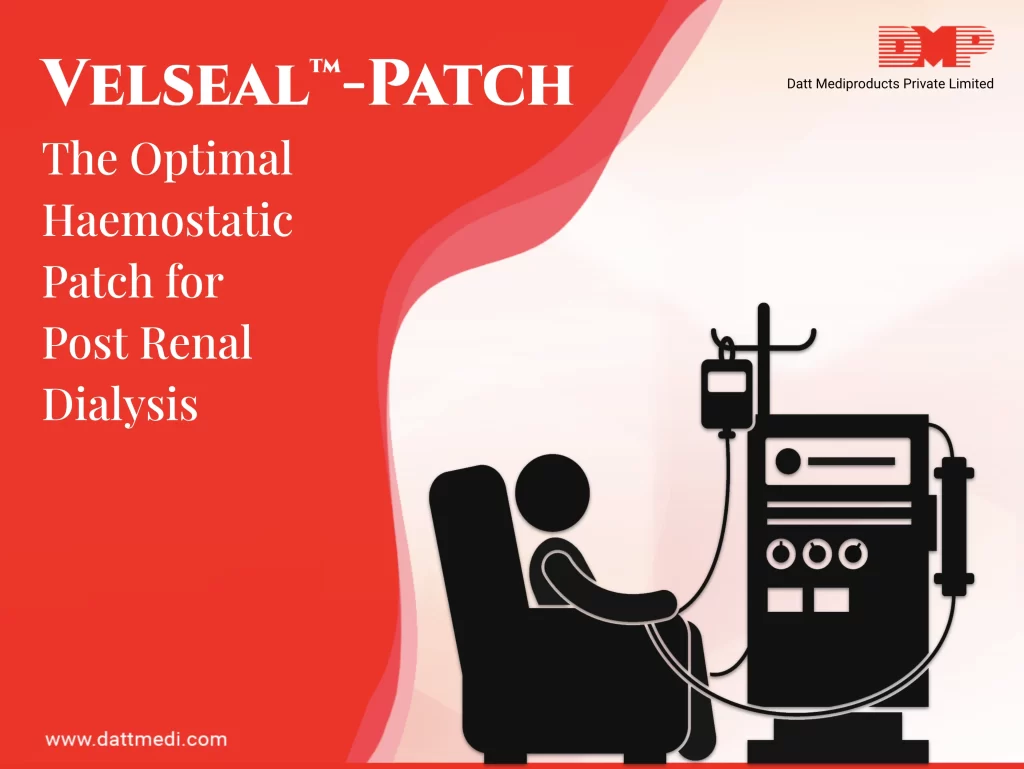
Dialysis is a treatment that filters and purifies the blood in your body by passing it through a machine to be cleaned. We need dialysis when the kidneys stop working properly.
Dialysis does some of the things done by healthy kidneys, which includes removing waste, salt and extra water to prevent them from building up in the body. This helps in keeping safe levels of certain chemicals in your body for example potassium, sodium, and bicarbonate.
DIALYSIS NEED:
A person needs dialysis on developing an end-stage renal failure, which is indicated by an 85-90% kidney function loss and a glomerular filtration rate of less than 15.
Do You Know?
An average life expectancy on dialysis is only 5-10 years, however, dialysis has helped patients to live for 20 or even 30 years.
Current Procedure for post-hemodialysis bleeding:
It’s important to stop blood loss post renal dialysis, as soon as possible. It is seen as a simple problem but many times it is very difficult to manage.
Post-hemodialysis site haemorrhage (PHSH) requires a lot of time, effort and expertise to stop. This is also because of the anti-coagulants, like heparin, which has been given to the patients as a part of the dialysis procedure so that blood flows freely through the fistula or graft.
These anti-coagulants make the blood thin and thus bleeding occurs more easily and is harder to stop. There are different steps, which can be followed to stop post-hemodialysis bleeding at the puncture site.
The main two steps used are:
1. DIRECT PRESSURE:
A firm pressure applied right on the bleeding spot with a gauze or cotton roll until the bleeding stops. The amount of time required to stop the bleeding with direct pressure can vary. In some cases, it takes only 20-30 minutes and in certain cases when the patient also suffers from other medical conditions, like high B.P, a low platelet count or diabetes, it can take anywhere from 50 minutes to upward of an hour. Once the bleeding has stopped a fresh gauze and tape is applied.
2 TORNIQUET:
A sterile elastic tourniquet can also be applied along with direct pressure to stop bleeding. Strong & direct pressure is an important intervention for hemorrhage control but it has been observed that strong pressure will often result in reducing the life of fistula. There can be various difficulties in achieving prompt hemodialysis-site hemostasis that contributes to further blood loss. It also consumes valuable staff time treating and monitoring these patients. We understand that there is a need for improved haemostasis dressing with active clotting surfaces and components to accelerate haemostasis in moderate to severe bleeding.
We @DattMediproducts introduce “VELSEALTM-PATCH”, an optimal haemostatic dressing to control bleeding Post-Renal Dialysis.
VELSEALTM – PATCH
VelSealTM-Patch is ready to use hemostatic dressing especially designed for renal dialysis patients. It consists of a polymeric haemostatic patch fixed on a non-woven fabric coated with adhesive. VelSealTM-Patch quickly stops bleeding as it fastens the blood clotting process and stabilizes the clotting formed.
Novel Features
- Nature of the dressing: A novel dressing with polymeric haemostatic patch to control bleeding at dialysis puncture sites. The hemostatic patch is impregnated with clot promoting and clot stabilizing agents.
- Porosity: VelSealTM-Patch is highly porous in nature and has the capacity to absorb fluids 12-15 times of its weight.
- Function: VelSealTM-Patch prevents the loss of natural clotting factors to initiate the clotting cascade.
- Adhesive Property: Adhesive is non-irritant and gentle to the skin. The sides of VelSealTM– Patch can be stuck to the skin hence eliminating the need for any secondary dressing.
- Indication: Used in post-haemodialysis patients to stop bleeding at the puncture site.
- Mode of Action: When blood flows into the dressing, the clotting process starts. The haemostatic patch expands after absorbing the blood. The clotting process occurs within the pores of the dressing. Clotting factors present in the dressing fasten the clotting process. The clot stabilizing agent prevents the disintegration of the clot formed.
- Size available: 5cm x 7cm
We @DattMediproducts provide a range of hemostatic dressings specially designed for some difficult to manage indications like Angiography/ Angioplasty, trauma, and artierla and venous ruptures to name a few. You can follow our previous blogs to know more about our innovative dressings and our patented products.





